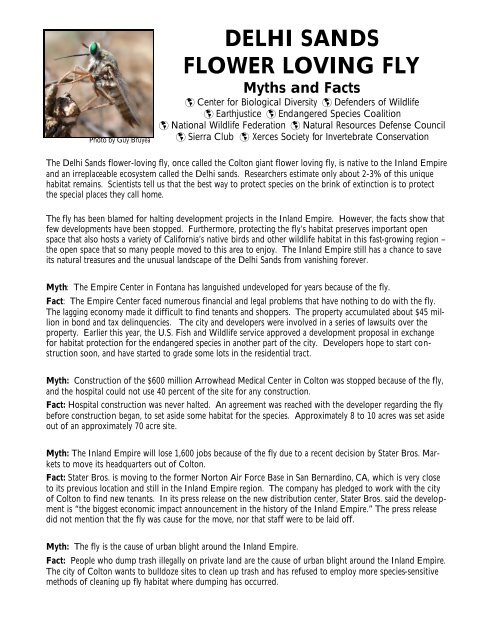DELHI SANDS FLOWER LOVING FLY - The Xerces Society
DELHI SANDS FLOWER LOVING FLY - The Xerces Society
DELHI SANDS FLOWER LOVING FLY - The Xerces Society
Create successful ePaper yourself
Turn your PDF publications into a flip-book with our unique Google optimized e-Paper software.
Photo by Guy Bruyea<strong>DELHI</strong> <strong>SANDS</strong><strong>FLOWER</strong> <strong>LOVING</strong> <strong>FLY</strong>Myths and Factsþ Center for Biological Diversity þ Defenders of Wildlifeþ Earthjustice þ Endangered Species Coalitionþ National Wildlife Federation þ Natural Resources Defense Councilþ Sierra Club þ <strong>Xerces</strong> <strong>Society</strong> for Invertebrate Conservation<strong>The</strong> Delhi Sands flower-loving fly, once called the Colton giant flower loving fly, is native to the Inland Empireand an irreplaceable ecosystem called the Delhi sands. Researchers estimate only about 2-3% of this uniquehabitat remains. Scientists tell us that the best way to protect species on the brink of extinction is to protectthe special places they call home.<strong>The</strong> fly has been blamed for halting development projects in the Inland Empire. However, the facts show thatfew developments have been stopped. Furthermore, protecting the fly’s habitat preserves important openspace that also hosts a variety of California’s native birds and other wildlife habitat in this fast-growing region –the open space that so many people moved to this area to enjoy. <strong>The</strong> Inland Empire still has a chance to saveits natural treasures and the unusual landscape of the Delhi Sands from vanishing forever.Myth: <strong>The</strong> Empire Center in Fontana has languished undeveloped for years because of the fly.Fact: <strong>The</strong> Empire Center faced numerous financial and legal problems that have nothing to do with the fly.<strong>The</strong> lagging economy made it difficult to find tenants and shoppers. <strong>The</strong> property accumulated about $45 millionin bond and tax delinquencies. <strong>The</strong> city and developers were involved in a series of lawsuits over theproperty. Earlier this year, the U.S. Fish and Wildlife service approved a development proposal in exchangefor habitat protection for the endangered species in another part of the city. Developers hope to start constructionsoon, and have started to grade some lots in the residential tract.Myth: Construction of the $600 million Arrowhead Medical Center in Colton was stopped because of the fly,and the hospital could not use 40 percent of the site for any construction.Fact: Hospital construction was never halted. An agreement was reached with the developer regarding the flybefore construction began, to set aside some habitat for the species. Approximately 8 to 10 acres was set asideout of an approximately 70 acre site.Myth: <strong>The</strong> Inland Empire will lose 1,600 jobs because of the fly due to a recent decision by Stater Bros. Marketsto move its headquarters out of Colton.Fact: Stater Bros. is moving to the former Norton Air Force Base in San Bernardino, CA, which is very closeto its previous location and still in the Inland Empire region. <strong>The</strong> company has pledged to work with the cityof Colton to find new tenants. In its press release on the new distribution center, Stater Bros. said the developmentis “the biggest economic impact announcement in the history of the Inland Empire.” <strong>The</strong> press releasedid not mention that the fly was cause for the move, nor that staff were to be laid off.Myth: <strong>The</strong> fly is the cause of urban blight around the Inland Empire.Fact: People who dump trash illegally on private land are the cause of urban blight around the Inland Empire.<strong>The</strong> city of Colton wants to bulldoze sites to clean up trash and has refused to employ more species-sensitivemethods of cleaning up fly habitat where dumping has occurred.
Myth: Federal officials dropped the ball on completing a multi-species regional Habitat Conservation Planthat would have solved issues surrounding the fly and other Inland Empire endangered plants and animals.Fact: <strong>The</strong> Fish and Wildlife Service finished a draft Habitat Conservation Plan, but it was immediately rejectedby the city of Colton. Instead of working on collaborative solutions, the city spent taxpayer money lobbyingCongress for delisting of the fly.Myth: Congress can delist the fly.Fact: <strong>The</strong> U.S. Fish and Wildlife Service, not Congress, is charged with overseeing the endangered specieslist. Species are removed if they have gone extinct or are recovered. We owe it to our children and grandchildrento be good stewards of the environment and leave behind a legacy of protecting endangered species andtheir habitats in the Inland Empire. We have a responsibility to protect species on the brink of extinction andwork towards recovering them so that they can be removed from the endangered species list.Contacts:• Dan Silver, Executive Director, Endangered Habitats League,(213) 804-2750, dsilverla@earthlink.net• Terry Wold, Conservation Program Director, Sierra Club, San Gorgonio Chapter,(951) 684-6203, terrywold@sbcglobal.net.
















